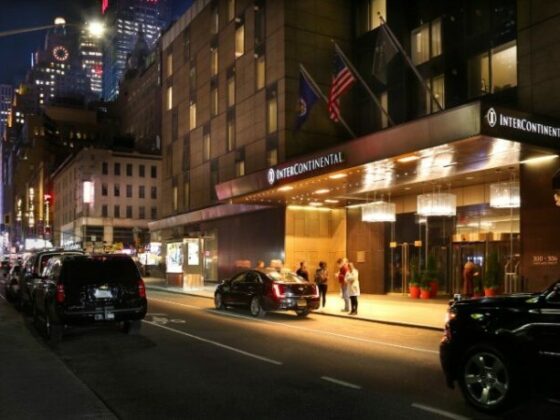As a seasoned observer and expert analyst of the hotel markets for 15 years, Adrien Lanotte, Chief Economist at MKG Consulting, is undoubtedly one of the most insightful commentators on market behavior. He shares his perspective on hotel activity in 2024 and provides a preview of what to expect in 2025.
The term “atypical” is often used to describe 2024 in terms of hotel activity. Would you agree with this characterization?
Yes, indeed. The year 2024 was atypical, as there were virtually no months that could be described as “normative” from a business perspective. In other words, there were no periods when the dynamics were solely driven by structural factors. Instead, every month was influenced by cyclical factors—some more exceptional than others—which complicated analysis. This led to significant variations, making 2024 atypical in terms of both profile and volatility, with significant and, at times, unpredictable fluctuations.
Does this mean 2024 is an outlier, and we’ll return to a more predictable situation? Or does it indicate a more complex scenario moving forward?
2024 was marked by numerous exceptional events in Europe, particularly in its two main markets: the Paris Olympics in France and the UEFA European Football Championship in Germany. Thankfully, this level of complexity is not likely to be a permanent feature. Structural analyses remain relevant. For instance, France and the UK were the first markets to recover from the COVID-19 crisis, so it is logical that they are the first to experience a leveling off compared to the rebound years. In contrast, Spain in 2024 was not atypical at all. On the contrary, it was a year that confirmed the country’s structural growth trajectory, reflected in market share gains. Regarding France, such significant monthly fluctuations are unlikely to persist.
Can we then talk about normalization, even if it means potential stagnation in the coming months?
We have indeed reached a plateau in certain markets, and the cyclical nature of hotel pricing and occupancy rates will regain relevance. While fluctuations in France were exaggerated, the structural dynamics remain intact. The real question now concerns the increasingly differentiated behavior of customer segments, and consequently, demand. Significant questions remain in France regarding domestic clientele, which could be extended to non-affluent European travelers. What impact will budget trade-offs, already reflected in overnight stay volumes, have?
How is this different from previous crisis?
Take the Subprime crisis or the post-9/11 period, for example. Back then, declines in hotel demand were initially international and affected the upper segments first. Luxury properties lowered their prices, compressing activity from the top down, forcing other segments to follow suit. This time, we have two distinct sub-markets: entry-level categories, which are fully experiencing the impact of challenges faced by domestic clientele, and the luxury and high-end segments, which continue to thrive. American travelers and those with strong dollar purchasing power (including from emerging markets) are living their “best lives” in Europe, with unprecedented spending power.
“This time, we have two distinct sub-markets: entry-level categories, which are fully experiencing the impact of challenges faced by domestic clientele, and the luxury and high-end segments, which continue to thrive”.
Which markets and categories have performed best in this environment?
High-end destinations like Paris and the Côte d’Azur have outperformed, benefiting from international exposure. If economic and social factors remain unchanged, these trends are likely to continue. Europe remains highly attractive and culturally appealing to these clientele segments.
Does this affluent clientele further emphasize the leisure dimension of the offer?
Perhaps, but motivations are not entirely dichotomous. The high-end segment has performed well in France and Germany across both leisure and business travel. The MICE (Meetings, Incentives, Conferences, and Exhibitions) segment has also seen a strong recovery. While the leisure sector saw a boost in regions like the Côte d’Azur and the mountains toward the end of the year, other leisure-heavy areas, such as the Atlantic coast and Brittany, struggled due to climate-related factors.
Are we facing a “glass ceiling” in terms of growth?
The post-COVID catch-up in occupancy rates has ended in most European markets, except for Eastern Europe, which continues to attract interest due to competitive pricing. The “revenge travel” effect is behind us, and future occupancy rate growth will likely be slower or even negative in some markets, with increased difficulties expected for certain types of travel.
Has part of the hotel clientele shifted significantly toward alternative accommodation?
Yes, to some extent, as short-term rental offerings have continued to expand. Platforms such as Booking.com, Expedia, and Airbnb have made these options even more accessible. However, this doesn’t entirely explain changes in fundamentals. Alternative accommodations have existed for some time, and their slower growth in recent years has supported hotel dynamics.
So, there’s no inevitability about occupancy rate declines?
Occupancy rates have decreased in France, but they are rising—and rising sharply—elsewhere in Europe. This is particularly true for Eastern Europe and Spain, which has been proactive in regulating short-term rentals. This suggests that the interplay between hotels and private rentals can work both ways.
Has France been too lenient in this regard?
There is indeed an issue with the development of hotel supply in France, which is increasingly constrained. The explosion of Airbnb offerings can be seen as a consequence. The Olympics had little impact on increasing hotel supply, unlike in London or Rio. Ultimately, Paris relied on existing accommodations, much like its approach to sports infrastructure. The good news is that this approach (shortage of supply) could lead to substantial revenue growth in the future.
“There is indeed an issue with the development of hotel supply in France, which is increasingly constrained. The explosion of Airbnb offerings can be seen as a consequence”.
Isn’t this a short-term strategy, benefiting from supply shortages?
There are positive factors to consider, such as the return of MICE events and improved transportation links, which have boosted the appeal of various areas, particularly in Paris. The focus remains on creating value for investors. Today, converting and upgrading existing buildings offers more potential than developing new properties, which has become increasingly difficult.
Were there any regions or countries that stood out in this “atypical” year?
Southern Europe continued to perform well overall, with Spain delivering particularly positive surprises. Germany met expectations regarding the UEFA European Football Championship’s impact. Perhaps the biggest surprise of 2024 was the strength of leisure events, particularly in Germany. Concert tours by artists like Taylor Swift, Adele, and Coldplay turned Munich—a traditionally business-oriented destination—into one of the hottest summer tourism spots.
Additionally, I’ve been closely observing the late-year rebound in Central and Eastern Europe (Poland, Hungary, the Czech Republic, etc.). It remains to be seen if this trend will continue, but it seems logical, given that these destinations are attractive drawn by low-cost labor to leisure travelers seeking affordable options and business clients.
Can you share any insights into 2025 forecasts?
MKG Consulting publishes a Forecast 2025 report, available by subscription, but I can share some key trends.
Southern Europe, particularly Iberia (Spain and Portugal), will likely see occupancy rates decline as hotel prices continue to soar due to strong demand. Despite this, the market remains solid.
France and the UK, as early post-COVID recovery leaders, have already experienced corrections in occupancy rates. While the UK could see macroeconomic improvements, France will likely face mixed comparisons influenced by exceptional 2024 factors.
In Northwestern Europe, Germany will be under scrutiny. While it gained significant market share in the MICE segment, replicating 2024’s high benchmark will be challenging, especially given the country’s industrial challenges. The Netherlands also faces prolonged impacts from fiscal measures and supply restrictions in Amsterdam.
Central Europe is expected to continue gaining market share, supported by strong international demand. However, much depends on geopolitical factors, such as the conflict in Ukraine and potential economic shifts under the next U.S. administration.







